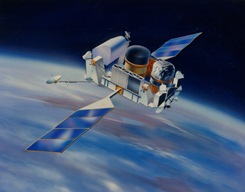Compton Gamma Ray Observatory
|
|

| |
| Artist's Illustration of CGRO in orbit (credit: NASA) | |
| Organization | NASA |
| Wavelength regime | gamma ray |
| Orbit Height | 450 km |
| Orbit period | 90 min |
| Launch date | 5 April 1991 |
| Deorbit date | 4 June 2000 |
| Mass | 17000 kg |
| Webpage | http://cossc.gsfc.nasa.gov/ |
| Physical Characteristics | |
|---|---|
| Telescope Style | scintillation detectors |
| Diameter | N/A |
| Collecting Area | varied by instrument |
| Effective Focal Length | N/A |
| Instruments | |
| BATSE | all-sky monitor |
| OSSE | pointed detectors |
| COMPTEL | imaging telescope |
| EGRET | wide field telescope |
The Compton Gamma Ray Observatory (CGRO) was the second of the NASA "Great Observatories" to be launched to space, following the Hubble Space Telescope.
CGRO was launched on the Space Shuttle Atlantis, mission STS-37, on 5 April 1991. It was the heaviest astrophysical payload ever flown at that time. After one of its gyros failed, the observatory was deliberately de-orbited. NASA decided that a controlled crash was preferable, in the interest of public safety, to letting the craft come down on its own. It entered the Earth's atmosphere on 4 June 2000, with debris falling harmlessly into the Pacific Ocean.
CGRO carried a complement of four instruments that covered an unprecedented six decades of the electromagnetic spectrum, from 20 keV to 30 GeV. In order of increasing spectral energy coverage:
- Burst and Transient Source Experiment (BATSE) by NASA Marshall Space Flight Center searched the sky for short duration gamma ray bursts (20 to 600 keV) and conducted full sky surveys for long-lived sources. It consisted of 8 detectors.
- Oriented Scintillation Spectrometer Experiment (OSSE) by the Naval Research Laboratory detected gamma rays entering the field of view of any of four detectors, which could be pointed individually, in the 0.05 to 10 MeV range.
- Imaging Compton Telescope (COMPTEL) by Max Planck Institute and the University of New Hampshire was tuned to the 1-30 MeV energy range and determined the angle of arrival of photons to within a degree and the energy to within five percent at higher energies.
- Energetic Gamma Ray Experiment Telescope (EGRET) measured high energy (20 MeV to 30 GeV) gamma ray source positions to a fraction of a degree and photon energy to within 15 percent. EGRET was developed by NASA Goddard Space Flight Center, Max Planck Institute, and Stanford University.
One great accomplishment of the CGRO was the discovery of terrestrial gamma ray sources in 1994 that come from thunderclouds.
The observatory was named after Dr. Arthur Compton, Nobel prize winner for work involved with gamma ray physics.
See Also
External links
- NASA Compton Gamma Ray Observatory site (http://cossc.gsfc.nasa.gov/)
- New Scientist (http://www.newscientist.com/channel/space/mg18524885.400/)de:Compton Gamma Ray Observatory
fr:Compton Gamma-Ray Observatory pl:Teleskop kosmiczny Comptona
